论文完成稿---英汉颜色词对比及翻译
- 格式:doc
- 大小:49.50 KB
- 文档页数:8
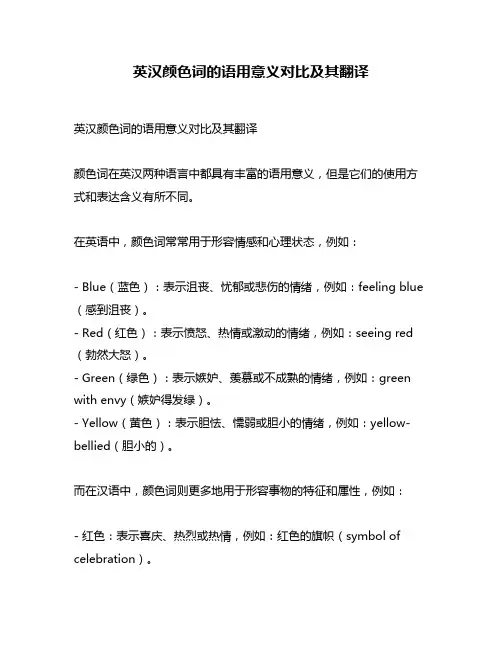
英汉颜色词的语用意义对比及其翻译
英汉颜色词的语用意义对比及其翻译
颜色词在英汉两种语言中都具有丰富的语用意义,但是它们的使用方式和表达含义有所不同。
在英语中,颜色词常常用于形容情感和心理状态,例如:
- Blue(蓝色):表示沮丧、忧郁或悲伤的情绪,例如:feeling blue (感到沮丧)。
- Red(红色):表示愤怒、热情或激动的情绪,例如:seeing red (勃然大怒)。
- Green(绿色):表示嫉妒、羡慕或不成熟的情绪,例如:green with envy(嫉妒得发绿)。
- Yellow(黄色):表示胆怯、懦弱或胆小的情绪,例如:yellow-bellied(胆小的)。
而在汉语中,颜色词则更多地用于形容事物的特征和属性,例如:
- 红色:表示喜庆、热烈或热情,例如:红色的旗帜(symbol of celebration)。
- 黄色:表示温暖、明亮或轻松,例如:黄色的阳光(warm and bright sunlight)。
- 蓝色:表示清新、冷静或深邃,例如:蓝色的天空(fresh and calm sky)。
- 绿色:表示生机、健康或环保,例如:绿色的植物(healthy and eco-friendly plants)。
除此之外,颜色词在不同的文化和语境中也可能具有不同的意义和象征意义。
例如,在西方文化中,白色通常表示纯洁和清新,而在中国文化中,白色则常常被视为丧葬和哀悼的象征。
总之,颜色词在英汉两种语言中都是非常重要的词汇,它们的语用意义和表达方式也都具有一定的差异。
因此,在进行跨文化交流和翻译时,我们需要注意这些差异,以避免产生误解和文化冲突。

从颜色词看中英文化差异摘要我们生活在五彩缤纷、五颜六色的世界中,颜色的多样性造成了与之相对应的颜色词的丰富多彩。
颜色词除了可以表示最基本的大自然绚丽色彩的意义以外,在某种程度上也体现了人类的一些价值观和审美观。
在这种情况下,颜色词已不单纯是表示客观颜色的指称意义了,而是被赋予了不同的象征意义,而不同文化背景的人们对颜色的感知和审美体验是同中有异,异中有同。
本文将选取几个典型的颜色词来分析颜色词在中英文化中所存在的共性和差异性,探讨形成这种差异性的各种原因,并浅略讲述其对跨文化沟通、交流的影响及解决办法。
关键词:颜色词联想意义文化差异跨文化交际Chinese and English Cultural Differences Reflected in the ColorTermsAbstractAs we live in a colorful world, the diversity of colors results in the diversity of the equivalent color terms. Apart from expressing the most basic colors in the nature, colors, to some extent, represent some values and aesthetics of the mankind. In this case, color terms no longer merely express the designative meaning of the objective colors. They are given different symbolic meanings. People with different cultural background have different perceptions and aesthetic experience about colors, in which similarities can be found.This paper will select a few typical color terms to analyze the similarities and differences of color terms in Chinese and English cultures, discuss various reasons for these similarities, and touches upon their influence on the cross-cultural communication and exchanges and the solutions.Key words:color terms, associative meaning, cultural differences, cross-cultural communication目录引言 (1)1、中英两种文化中的颜色词及在跨文化交际中的翻译误区 (1)1.1、中英两种文化中的颜色词 (1)1.2、跨文化交际中颜色词的翻译误区 (1)2、颜色词在中英文化中的不同内涵,其共性与差异性 (1)2.1、白色(white) (2)2.2、红色(red) (2)2.3、黄色(yellow) (3)3、颜色词在中英文化中形成差异性的原因 (3)3.1、文化差异的原因 (4)3.2、价值取向的原因 (4)3.3、思维方式的原因 (5)3.4、宗教方面的原因 (5)3.5、其它原因 (5)4、颜色词的差异性对跨文化交流的影响 (6)5、在跨文化交流中应如何正确理解和翻译颜色词 (6)5.1、直译法 (6)5.2、意译法 (6)5.3、更换颜色词的翻译法 (7)5.4、增加颜色词的翻译法 (7)6、结语 (7)7、参考文献 (8)从颜色词看中英文化差异引言色彩与人类的生活息息相关,是人类认识世界的一个重要领域。
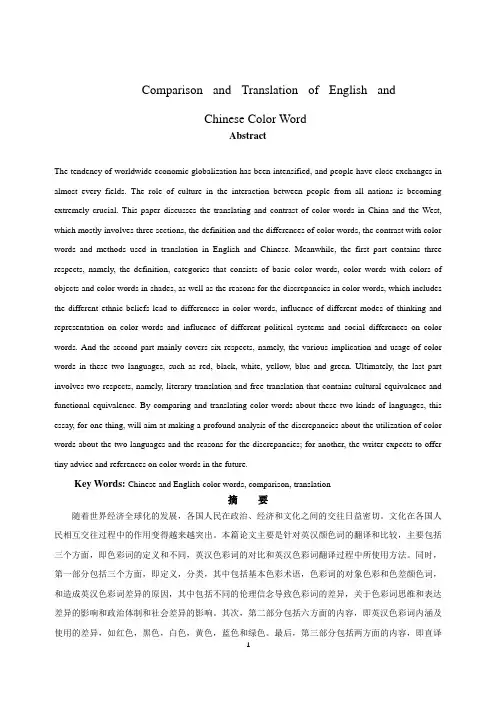
Comparison and Translation of English andChinese Color WordAbstractThe tendency of worldwide economic globalization has been intensified, and people have close exchanges in almost every fields. The role of culture in the interaction between people from all nations is becoming extremely crucial. This paper discusses the translating and contrast of color words in China and the West, which mostly involves three sections, the definition and the differences of color words, the contrast with color words and methods used in translation in English and Chinese. Meanwhile, the first part contains three respects, namely, the definition, categories that consists of basic color words, color words with colors of objects and color words in shades, as well as the reasons for the discrepancies in color words, which includes the different ethnic beliefs lead to differences in color words, influence of different modes of thinking and representation on color words and influence of different political systems and social differences on color words. And the second part mainly covers six respects, namely, the various implication and usage of color words in these two languages, such as red, black, white, yellow, blue and green. Ultimately, the last part involves two respects, namely, literary translation and free translation that contains cultural equivalence and functional equivalence. By comparing and translating color words about these two kinds of languages, this essay, for one thing, will aim at making a profound analysis of the discrepancies about the utilization of color words about the two languages and the reasons for the discrepancies; for another, the writer expects to offer tiny advice and references on color words in the future.Key Words: Chinese and English color words, comparison, translation摘要随着世界经济全球化的发展,各国人民在政治、经济和文化之间的交往日益密切。
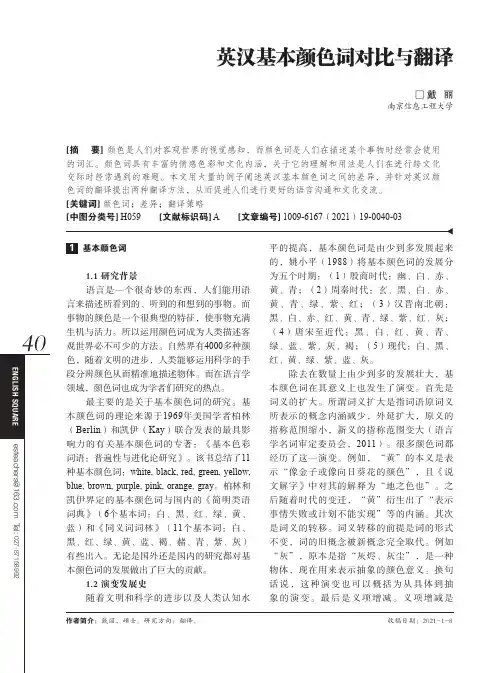
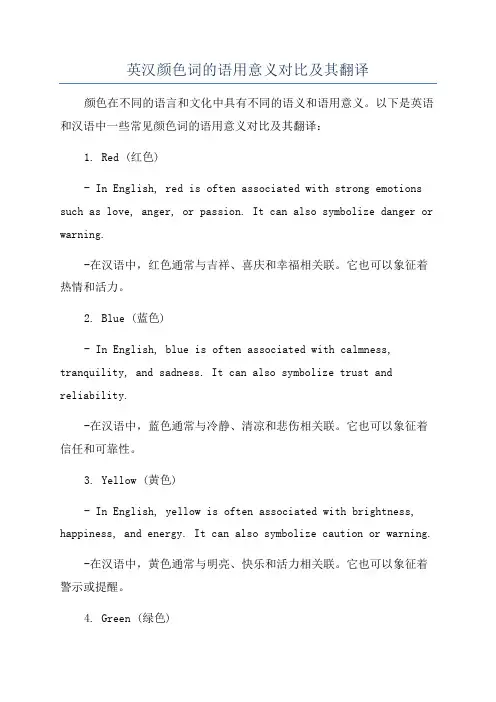
英汉颜色词的语用意义对比及其翻译颜色在不同的语言和文化中具有不同的语义和语用意义。
以下是英语和汉语中一些常见颜色词的语用意义对比及其翻译:1. Red (红色)- In English, red is often associated with strong emotions such as love, anger, or passion. It can also symbolize danger or warning.-在汉语中,红色通常与吉祥、喜庆和幸福相关联。
它也可以象征着热情和活力。
2. Blue (蓝色)- In English, blue is often associated with calmness, tranquility, and sadness. It can also symbolize trust and reliability.-在汉语中,蓝色通常与冷静、清凉和悲伤相关联。
它也可以象征着信任和可靠性。
3. Yellow (黄色)- In English, yellow is often associated with brightness, happiness, and energy. It can also symbolize caution or warning.-在汉语中,黄色通常与明亮、快乐和活力相关联。
它也可以象征着警示或提醒。
4. Green (绿色)- In English, green is often associated with nature, growth, and freshness. It can also symbolize envy or jealousy.-在汉语中,绿色通常与自然、成长和新鲜相关联。
它也可以象征着嫉妒或羡慕。
5. Black (黑色)- In English, black is often associated with darkness, sadness, formality, and elegance. It can also symbolize mystery or power.-在汉语中,黑色通常与黑暗、悲伤、庄重和优雅相关联。
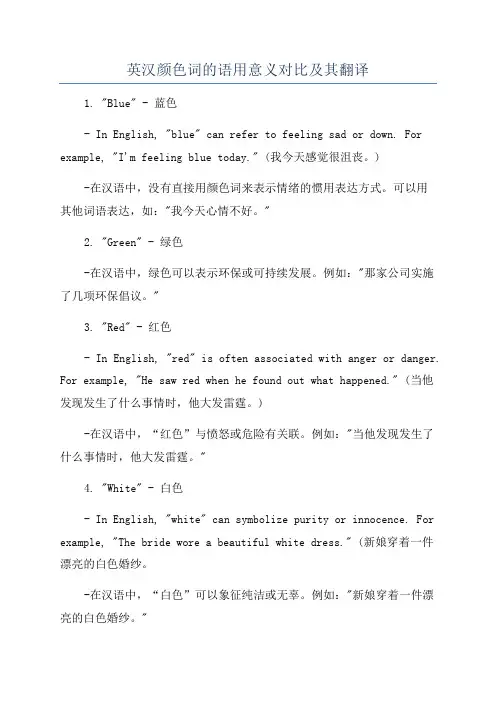
英汉颜色词的语用意义对比及其翻译1. "Blue" - 蓝色- In English, "blue" can refer to feeling sad or down. For example, "I'm feeling blue today." (我今天感觉很沮丧。
) -在汉语中,没有直接用颜色词来表示情绪的惯用表达方式。
可以用其他词语表达,如:"我今天心情不好。
"2. "Green" - 绿色-在汉语中,绿色可以表示环保或可持续发展。
例如:"那家公司实施了几项环保倡议。
"3. "Red" - 红色- In English, "red" is often associated with anger or danger. For example, "He saw red when he found out what happened." (当他发现发生了什么事情时,他大发雷霆。
)-在汉语中,“红色”与愤怒或危险有关联。
例如:"当他发现发生了什么事情时,他大发雷霆。
"4. "White" - 白色- In English, "white" can symbolize purity or innocence. For example, "The bride wore a beautiful white dress." (新娘穿着一件漂亮的白色婚纱。
-在汉语中,“白色”可以象征纯洁或无辜。
例如:"新娘穿着一件漂亮的白色婚纱。
"5. "Black" - 黑色- In English, "black" can represent something negative or illegal. For example, "He's involved in some black market activities." (他涉及了一些黑市活动。
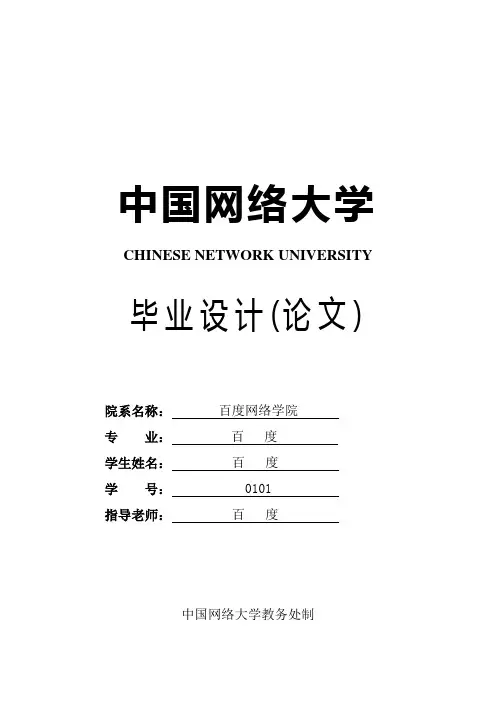
中国网络大学CHINESE NETWORK UNIVERSITY 毕业设计(论文)院系名称:百度网络学院专业:百度学生姓名:百度学号:0101指导老师:百度中国网络大学教务处制2019年05月16日The Contrast of Color Terms between English and ChineseIntroductionIn both Chinese and English. There are a great number of color terms expressing the colors in the world.Color terms are a part of language , and color terms’translation is important in today’s society. Lots of classic works are rich with color terms. Correct and accurate color terms’ translation helps to transmit the meaning of the source text..Language belongs to culture, Cultural backgrounds causes differences between English and Chinese . Color terms are endowed with various emotions between English and Chinese. It is necessary to learn the cultural connotation of color terms before learning the nation’s language. This thesis, firstly, give the definition of color terms. In this part, it is emphasized the classification and the function of color terms. From the part of classification , we will introduce it one by one. As the part of function, it’s mainly introduce three functions, namely, informative function, emotive function, and performative function. Secondly, it give the appropriate application in translating basic color terms, the appropriate application play an important roles in translation. We illustrate this point by the usages and cultural connotation of basic color terms. Thirdly, we introduce the translation techniques of color terms, we mainly introduce four kinds of translation techniques, they are creative translation, liberal translation, literal translation, and annotation.1. The Definition of Color TermsFrom “Oxford advanced Learner’s English and—Chinese Dictionary”, color is the appearance that things have that results from the way in which they reflect light. And all of those terms used to describe colors are called ‘color terms’. Both Englishand Chinese have abundant vocabulary of color words. The color terms play an important role in culture and communication. They have the special linguistic functions and cultural implications. They introduce the consciousness to the color in each nations and its traditional culture. The same color has different meanings in different contexts, which is decided by the cultural backgrounds.1.1 Classification of Color TermsIt’s mainly we have two kinds of color terms. Basic color terms mean “words used to describe the color of objects when they appear.”. Basic color terms originated from Anglo-Saxon including seven kinds of colors. In English , there are ‘red, orange , yellow, green, blue, indigo and violet”. However ,during these seven color words each has different symbolic meanings between the two countries, because different language might use different color terms to describe the same object or phenomenon. Now, I’d like to introduce them one by one.A Red Red is traditionally used by Chinese people to express happiness , luck and prosperousness as well as the English-speaking countries. So there are lots of similarities in using it. It usually appears in various festivals, for example , people decorate their houses with red lanterns and doublets. On wedding ceremony , people put up the red character “xi”, the bride is dressed in red , the bridegroom wears a red flower on his breast. The red flag means dignity. English people use a red carpet to welcome a VIP. A red carpet visitor[上宾]. The red-letter day means holidays such as Christmas and other special days. These days are printed in red on calendars, rather than in black for ordinary days, it often connects with success and importance. The phrase‘give somebody a red carpet of reception’means make a warm welcome to some important person. Red also means someone is healthy and sanguine both in China and the English-speaking countries. For example ‘a fine old gentlemen ,with a face as red as a rose.” These sentence means that the old gentlemen is very healthy and sanguine. Red is often used to show some emotions in English ,and also associated with anger and danger. For example, become red-faced, turn red and seered. Fire engine and alarm are printed as red to show danger in China. The expression “red bottle” means “song winery bottle”, and the expression “red vengeance” means rocking of bottle vengeance”. These expression can find the correct vocabulary both in English and in Chinese.B Black Black is not a good word both in Chinese and in English-speaking countries. In Chinese traditional culture , black symbolizes sorry and death. For example , in Chinese funeral, people usually wear a black armband to show their mourns to the death relative. Black ,on the one hand ,is used to describe evil and reactionary ,like “黑心肠”means somebody is very evil and “黑帮”is a group pf people who do things opposed to low. Black ,on the other hand, stand for solemnity. Chinese people usually wear black in some formals occasions. Black also stands for illegalness, for instance, “黑店” is the hotel which does illegal deals.In western countries, black is a tabooed color, which stands for darkness, it means hopelessness, sadness or melancholy. For instance “black future” means have no future. “black despair” means very great despair, “ a black day” means very angry, “a black mood” is in bad mood. Black means evil or wicked, for example , “ a black deed”means doing something against one’s conscience. Black also stands for solemnity and dignity; in this aspect, it is same as Chinese . “black suit”is the westerners’ favorite traditional dress. In solemn occasions ,the officials and celebrities would be pretty to dress in black.C White. When the color white is used express the meaning spotlessly. There are extremely similar point in English and in Chinese. There are phrases as “return me pure{ 还我清白} and “quite clear{清清白白} in Chinese. The white also symbolizes the pure things. For example, when getting married the bride always wears the long white skirt and veil, because it shows that bride is pure , and the wedding is scared. White in Chinese traditional culture is a basic taboo color. It means bereavement and stands for death and ill omen. People who lost relatives use white paper, wear white clothes and white caps , and the funeral is called “白事”. In Chinese feudal society, the common people were forbidden to dress in any other dress exceptwhite ,so they were called “白衣”, the person with no position are “白丁” or “白身” , their houses are “白屋”.White in western countries is an esteemed color. It stands for purify honesty uprightness, and luck. For example, at weeding, all the brides wear white. “a white day” means a lucky day, “a white girl” means an innocent girl. “white man” means trusty man. However, white also has derogatory meanings. For example, “show the white feather”, “white lipped”“a face white with fear”, “as white as a sheet” are all expressions of acting in a crowardly way. “W hite flag”symbolizes giving up on something.D Yellow In Chinese traditional culture, yellow is the symbol of old china 黄袍”is the emperor’s dress, “黄屋” is the prodamation published by him.. and “黄道吉日”means an auspicious day. However , yellow in modern China has derogatory meaning, such as “黄色书刊”“黄色录像”,here yellow has an extended meaning of obscenity and pornography.Yellow in the western countries mostly has negative meanings . here are some examples: “yellow alert” means alert in advance, “a yellow dog” means comtemptible person. “Y ellow looks”means suspicious looks . “yellow streak” means tending to be crowd and chicken-hearted. Yellow, in English speaking countries , also has some particular meanings which have no relationship with mood, for example, “ the yellow pages” is the telephone directory.E Green In the Chinese traditional culture. Green symbolizes everything that grows. In the feudal society , the dress of the government official on a lower level was regularized to be green, so it also symbolizes humble. “青山绿袍” is a symbol of low position, in the official career. And in Chinese if we say a man wears a green cap , it means that his wife isn’t loyal to him.Green in western countries usually stands for immaturity, inexperienced and easily being fooled. For instance, “a green hand” or “a green horn” refers to a simple and inexperienced and easily deceived person. Green is often used to describe extreme envy. “green-eyed”means jealous. Green is the symbol of flourishing, vigor. For example, “a green old age” is associated with an old but vigorous man or woman. “toremain green forever” means to keep fresh and vigorous forever.F Purple In Chinese culture, purple symbolizes nobility and dignity. It is more often adopted by the feudal emperors and the Taoism. The emperors’ palace is “紫禁城”{the forbidden city}, “紫气” , means auspicious air. The Taoism book are “紫书”,the place which the deity lives in is “紫台”. In modern China, we have“红得发紫”to describe popularity.In English, purple shares almost the same connotation as Chinese. In the eye of westerners purple is the symbol of emperor and power. “to be born in the purple”means to be born in a royal family. “ to be raided to the purple” means to be promoted to the position as a pope. “marry to the purple”means marry to a family of high social position. {陈亚平,Language Teaching and Linguistic status , 北京语言学院出版社} purple can be also used describe literature, such as “purple patches”means pompous passages.G Blue It seems that Chinese usually associate blue with sea and sky. It indicates peace and serenity, and can arouse us to yearn for a better future. For example, we often hear the political words “蓝图”which means the plan hope and has brought future.However , in the western countries, blue is often used to describe one’s emotions, it does not associate with happiness and imagination, but gloom and depression. Look at the following sentences: “ it was blue Monday” means it was boring Monday. “I am in a blue mood” means I am sad or gloomy. Blue also means indelicacy, obscenity, such as “blue film”“blue talk”. Blue is also often associated with high social status or being aristocratic. For example, “he is a real blue blood”means he is from an aristocratic family. In addition , in U.S., a book with the names of famous figures, especially top government officials, is called “blue book”.Object color terms mean “terms used to indicate colors which are the names of objects”.. Lots of these kinds of words exist in any kinds of languages, such as “ gold , silver, orange” in English, and “金黄色,米色,银色” in Chinese.1.2 Functions of Color termsCommonly, a color term has its own function. In source language, the author always uses the color terms to express the image of the text.1.2.1 Informative FunctionFor example, the color terms used in the following text form the landscape of an autumn evening.The ground was a carpet of deep reddish brown in the glow of an autumn evening sun, tempered by the trees. Yong birches sprang up, caught light on one side, and were sparkling green there; the shadowy sides of the stems were warm, deep black-green. Behind the spalings, behind the brownish red soil was a very delicate sky, bluish grey, warm , hardly blue ,all a glow. Against it were a hazy border of green and a net work of little stems and yellowish leaves. A few figures of wood gathers were wandering around like dark masses of mysterious shadows.”1.2.2 Emotive FunctionThe second function of color terms is emotive function. It is accepted that different colors give people different feelings. Experiences show that color terms are the best way to describe one’s emotion. An example is quoted below.“then the mourning clouds in the east turned deep red and sky above showed blue, the red clouds were pierced by golden rays, interweaving to spin a majestic, glittering web in the southeastern sky with the clouds as weft, the rays as warp. Fields, trees and wild grass changed their colors from dark green to bright emerald”.This paragraph was translated from the rickshaw boy written by Lao She. The color terms describe Xiang Zi’s feeling specifically after he had escaped from danger. Obviously, without color terms, the originally images can hardly be reproduced in the version.1.2.3Performative FunctionIt is first used in Linguistic Study written by Austin and Searle. Color terms in different languages have different social connotation. Two examples are given as fllows.The government has given the green light to Sunday treading.政府已经允许星期日贸易。
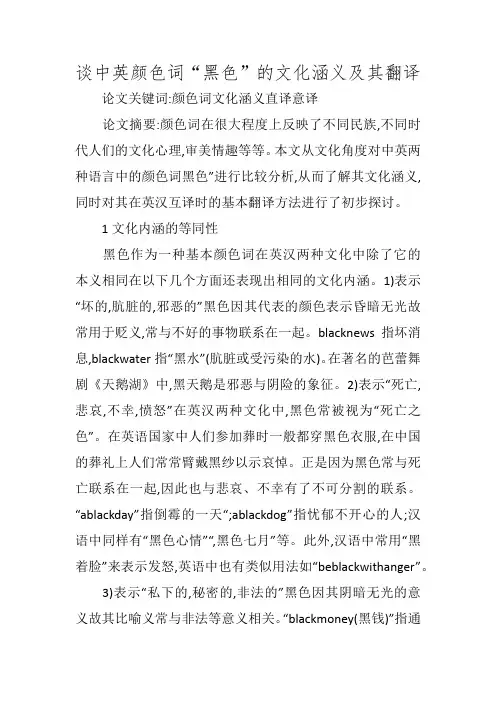
谈中英颜色词“黑色”的文化涵义及其翻译论文关键词:颜色词文化涵义直译意译论文摘要:颜色词在很大程度上反映了不同民族,不同时代人们的文化心理,审美情趣等等。
本文从文化角度对中英两种语言中的颜色词黑色”进行比较分析,从而了解其文化涵义,同时对其在英汉互译时的基本翻译方法进行了初步探讨。
1文化内涵的等同性黑色作为一种基本颜色词在英汉两种文化中除了它的本义相同在以下几个方面还表现出相同的文化内涵。
1)表示“坏的,肮脏的,邪恶的”黑色因其代表的颜色表示昏暗无光故常用于贬义,常与不好的事物联系在一起。
blacknews指坏消息,blackwater指“黑水”(肮脏或受污染的水)。
在著名的芭蕾舞剧《天鹅湖》中,黑天鹅是邪恶与阴险的象征。
2)表示“死亡,悲哀,不幸,愤怒”在英汉两种文化中,黑色常被视为“死亡之色”。
在英语国家中人们参加葬时一般都穿黑色衣服,在中国的葬礼上人们常常臂戴黑纱以示哀悼。
正是因为黑色常与死亡联系在一起,因此也与悲哀、不幸有了不可分割的联系。
“ablackday”指倒霉的一天“;ablackdog”指忧郁不开心的人;汉语中同样有“黑色心情”“,黑色七月”等。
此外,汉语中常用“黑着脸”来表示发怒,英语中也有类似用法如“beblackwithanger”。
3)表示“私下的,秘密的,非法的”黑色因其阴暗无光的意义故其比喻义常与非法等意义相关。
“blackmoney(黑钱)”指通过违法手段得到的不义之财,类似的还有“blackmarket(黑市)、blacklist(黑名单)black-hearted(黑心的,邪恶的)、blackdeeds(恶劣行径)。
汉语中同样有“黑户、黑钱、黑货、黑店”等等。
4)表示“庄重、正义”黑色除了表示消极意义也表示积极意义。
在我国古代,黑色是一种尊重和庄重的颜色,是夏朝和秦朝所崇尚的正色,缁衣(黑色帛做的衣服)则是卿士听朝的正服。
因黑色和铁的颜色相似,我国古人常将铁的坚硬特征与黑色联系起来,用黑色来象征“刚直、公正无私”,因此在中国戏曲脸谱艺术中,往往用黑色脸谱来象征历史人物的秉公执法,刚正不阿等高尚品质,最典型的代表是宋朝的包拯。
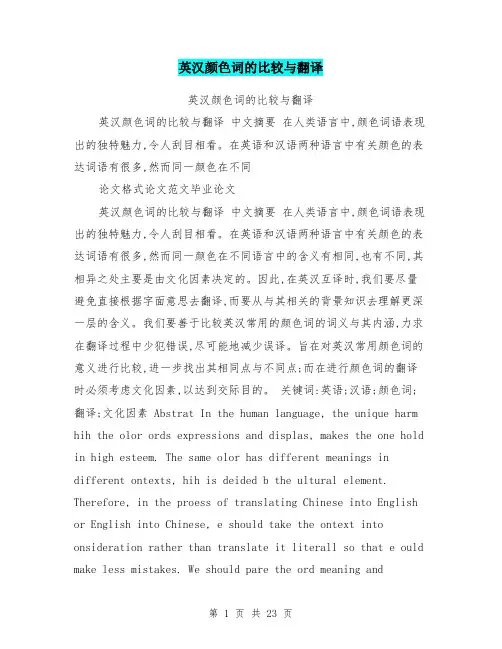
英汉颜色词的比较与翻译英汉颜色词的比较与翻译英汉颜色词的比较与翻译中文摘要在人类语言中,颜色词语表现出的独特魅力,令人刮目相看。
在英语和汉语两种语言中有关颜色的表达词语有很多,然而同一颜色在不同论文格式论文范文毕业论文英汉颜色词的比较与翻译中文摘要在人类语言中,颜色词语表现出的独特魅力,令人刮目相看。
在英语和汉语两种语言中有关颜色的表达词语有很多,然而同一颜色在不同语言中的含义有相同,也有不同,其相异之处主要是由文化因素决定的。
因此,在英汉互译时,我们要尽量避免直接根据字面意思去翻译,而要从与其相关的背景知识去理解更深一层的含义。
我们要善于比较英汉常用的颜色词的词义与其内涵,力求在翻译过程中少犯错误,尽可能地减少误译。
旨在对英汉常用颜色词的意义进行比较,进一步找出其相同点与不同点;而在进行颜色词的翻译时必须考虑文化因素,以达到交际目的。
关键词:英语;汉语;颜色词;翻译;文化因素 Abstrat In the human language, the unique harm hih the olor ords expressions and displas, makes the one hold in high esteem. The same olor has different meanings in different ontexts, hih is deided b the ultural element. Therefore, in the proess of translating Chinese into English or English into Chinese, e should take the ontext into onsideration rather than translate it literall so that e ould make less mistakes. We should pare the ord meaning andonnotation of olor ords in both English and Chinese languages, make ever effort to avoid the mistake in the translation proess and redue mistranslating. The paper tries to pare some olor ords in their usage, and further to explore thedifferene and similarit beteen English and Chinese. While translating olor ords, e must onsider the ultural element so that e ould ahieve the goal of muniation. Ke ords:English;Chinese;olor terms; translation; ulture fator 引言色彩与人类的生活息息相关,是人类认识世界的一个重要领域。
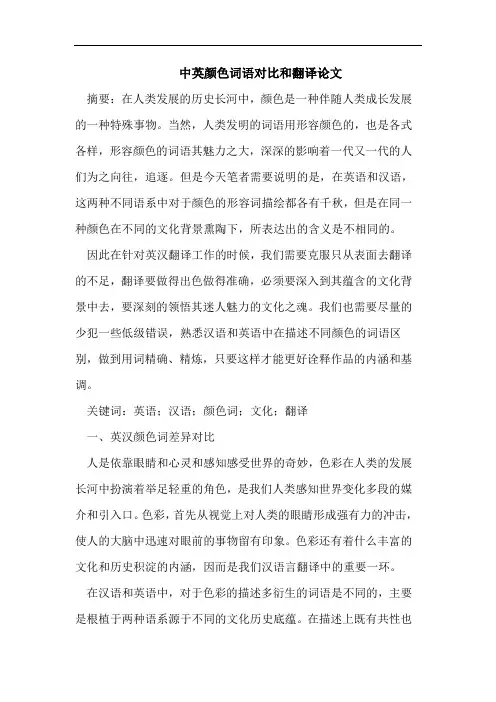
中英颜色词语对比和翻译论文摘要:在人类发展的历史长河中,颜色是一种伴随人类成长发展的一种特殊事物。
当然,人类发明的词语用形容颜色的,也是各式各样,形容颜色的词语其魅力之大,深深的影响着一代又一代的人们为之向往,追逐。
但是今天笔者需要说明的是,在英语和汉语,这两种不同语系中对于颜色的形容词描绘都各有千秋,但是在同一种颜色在不同的文化背景熏陶下,所表达出的含义是不相同的。
因此在针对英汉翻译工作的时候,我们需要克服只从表面去翻译的不足,翻译要做得出色做得准确,必须要深入到其蕴含的文化背景中去,要深刻的领悟其迷人魅力的文化之魂。
我们也需要尽量的少犯一些低级错误,熟悉汉语和英语中在描述不同颜色的词语区别,做到用词精确、精炼,只要这样才能更好诠释作品的内涵和基调。
关键词:英语;汉语;颜色词;文化;翻译一、英汉颜色词差异对比人是依靠眼睛和心灵和感知感受世界的奇妙,色彩在人类的发展长河中扮演着举足轻重的角色,是我们人类感知世界变化多段的媒介和引入口。
色彩,首先从视觉上对人类的眼睛形成强有力的冲击,使人的大脑中迅速对眼前的事物留有印象。
色彩还有着什么丰富的文化和历史积淀的内涵,因而是我们汉语言翻译中的重要一环。
在汉语和英语中,对于色彩的描述多衍生的词语是不同的,主要是根植于两种语系源于不同的文化历史底蕴。
在描述上既有共性也保持着两种语系的差异性和独特性,因此在翻译中,我们一定要明确这一层内涵,在将词语进行翻译表达时要明确其内涵和实意,在翻译出来的成品中要结合当地人们可接受的尺度进行展示。
本文笔者,针对英语和汉语中颜色词语的对比,分析其差异性,从而找到其异同点,在准确理解把握的前统下,对其进行统一的翻译表述。
例如:Mr. Brown is a very white man .He is looking rather green the other day. He has been feeling blue lately. When I saw him,he was in a brown study.I hope he’ll be in the pink again.表示顺利和成功时用:红榜(honor board)、开门红(get off to a good start)、满堂红(success in every field)、红歌星(a popular singer)等等。

英汉颜色词义探索色彩在文化心理和民族习俗中扮演着十分重要的角色,由于受地理环境、民情风俗、思维方式、宗教信仰、民族心理等因素的影响,各种颜色对于不同民族的人而言,在视觉和心理上所引发的联想和象征意义也不尽相同,甚至有较大差异。
下面列举几个主要颜色词在英语和汉语中的对比。
一、红色 red在英语和汉语中,红色有时可以完全对应,有时却大相径庭:红旗: red flag红糖: brown sugar红茶:black tea红榜: honor roll红豆: love pea红运: good luck红利:dividend红事: wedding红酒:red wine火灾: red ruin血战:red battle 彩霞: red skyred meat的本意为“红色的肉”,而英语中则表示“牛羊肉”,而white meat 则指烤鸡或烤火鸡颜色较浅、味道好的部分,不过鸡腿部位的肉叫做dark meat。
无论是在英语国家还是在中国,红色往往与庆祝活动或喜庆日子有关。
因为日历中,这些日子常用红色字体,因此,red letter day:指的是“纪念日”或“喜庆的日子”。
二、黄色 yellow黄色在英语和汉语中的引申含义差别比较大。
在英语中,yellow可以表示“胆小、卑怯、卑鄙”的意思。
eg:a yellow dog:可鄙的人,卑鄙的人a yellow livered:胆小鬼eg: yellow pages:黄页yellow book:黄皮书汉语中黄色一词有时象征低级趣味、色情庸俗、下流猥亵的意思,如黄色电影、黄色书刊、黄色光碟等等,这些名称中的“黄”与英语中的“yellow”无关。
能够表示汉语中这些意思的词汇应该是:pornographic(色情的)、vulgar(庸俗下流的)、obscene(猥亵的)等。
然而,英语中另一个颜色词blue却常用来表示汉语中这类意思,如blue jokes(下流的玩笑),blue films(黄色电影)等。
英语毕业论文颜色词的中英文文化差异Cultural Differences of Chinese and English Color WordsABSTRACTLanguage is a kind of social phenomenon and is the carrier of culture. Almost every language has color words, including Chinese and English. However, the words to describe colors differ from one language to another because of different customs, polities, religious beliefs etc. Different colors bring different symbolic meanings which have unique characteristics in each nation. As a result, it may lead to misunderstanding and even violate the taboos. The main purpose of this paper is to compare the differences between Chinese and English color words in terms of word building, history, politics, economy and daily usage to help people to have a better understanding of different cultures and to bridge the gap between different cultures in communication and to facilitate cultural exchange.Keywords: color word culture differences politics history daily usage颜色词的中英文文化差异摘要语言是一种社会现象,也是文化的载体。
1. 引言色彩与人类的生活息息相关,是人类认识世界的一个重要领域。
色彩不仅具有物理属性,还有着丰富的文化内涵。
在英汉两种语言中,均存在大量与颜色有关的表达方式,表达一种特定的文化内涵。
但由于英语与汉语分属于两个不同的文化语系,两个民族对同一颜色所产生的联想有共性,有差异性,也有时会完全相悖。
所以,在翻译这些带有颜色词的表达方式时,一定要弄清它们的实际含义,因为有时颜色词并不表示颜色,而是引申转换为其他的含义。
因此,本文将对英汉两种语言中的部分颜色词的语言特点、文化意义的异同进行比较,在加深理解的前提下,对该类词汇的翻译进行探讨。
2. 英汉颜色词的对比2.1 概念及分类英汉语中的颜色词数量都极为丰富。
“而英汉两种语言把颜色词大致分为三类:basic color words(基本颜色词),color words with colors of objects(实物颜色词),color words in shades(色差颜色词)。
”[1]对于基本颜色的概念,英汉两个民族的观念比较一致。
基本颜色词是指那些本来就可以表达事物色彩的颜色词。
英语与汉语对基本颜色词的分类差别不大,汉语中有赤、橙、黄、绿、青、蓝、紫,而英语中有red、white、black、green、yellow、blue、purple、gray、brown。
“实物颜色词就是把用自然界物体的本色来表示颜色的词。
例如:silver(银白),gold(金色),lead-gray(铅灰)这类颜色词广泛用于日常生活中。
”[1]“色差颜色词是指来自太阳的自然光或白光照射在各种颜色上有深浅明暗之分的颜色词。
例如: dark blue(深蓝),deep green(深绿),light yellow淡黄等等。
”[1]对于上述的分类,本文主要探讨部分常用基本颜色词的英汉比较及翻译,首先来比较这些基本颜色词之间的异同之处。
2. 2 基本颜色词比较在所有语言中,颜色词都具有极为丰富的意义。
ABSTRACTOwing to the differences in cognition and cultural backgrounds, the associative, symbolic and implied meaning of the English and the Chinese color terms are different. This article makes a comparison of the similarities and differences between the English color terms and the Chinese ones, with the purpose to raise the awareness of the color terms and provide a better understanding of the Chinese and different cognitive ways and cultural background, which will play an important role in the cross-culture communication.Key word: color terms; cognition; culture; similarities and differences中文摘要颜色与人们的生活息息相关,对颜色的认知也是人类的基本认知之一,人类的色彩感知用自然语言表达和固定下来就是自然语言中的各类颜色词语。
颜色词作为词汇中的重要组成部分,在人们的生活和交际中起着重要的作用。
受语言共同属性的影响,汉英颜色词在产生发展及功能用法上都表现出了强大的共性。
但是汉英两种语言毕竟孕育于不同的文化,在发展的过程中又受到各种背景的影响,其差异也是不言而喻的。
本文将分析和归纳汉英颜色词的相通性和差异性,以及造成这种相通性与差异性的原因,从而让人更好地理解汉英颜色词背后所蕴含的汉英两民族不同的观察视角和文化历史背景,对汉英跨文化交流起着巨大的帮助作用。
2019 9th International Conference on Social Science and Education Research (SSER 2019)The Semantic Contrast of Color Words between Chinese and English and TheirTranslationWenjia Wan1 and Yanfang Fan21************************************************************************2********************************************************Abstract. There are many color words in all kinds of languages in the world. In essence, color word is a symbol that conveys information with color language, and its connotation is the same for all nations in the world. However, due to the differences in living environment, geographical location and religious belief, there are considerable differences in the understanding and cognition of color words. Chinese and English cultures have a long history, and there are both similarities and great differences in the origin, development, semantic meaning and application of color words under two different cultural backgrounds. In this paper, the comparison and analysis from the perspective of language and culture background of English color words with meaning equivalence and differences and its translation, for some color words in chinese-english two languages as well as the similarities and differences of the language characteristics, cultural significance, and then expounds the understanding of the language vocabulary cannot be separated from specific language environment, so as to reach the correct understanding of words and transformation between different languages, to help us better understand and use the language and culture. Understanding and mastering these color words and the cultural differences they constitute is of practical significance for cross-cultural communication and translation activities.Key words: Color Words, Pragmatic Meaning, Comparative Analysi, Cultural Context1. IntroductionEnglish, like Chinese, has many words for color. Color words are symbols that use color language to convey information or express emotions [1]. Color has a kind of visual ability. Since human beings have the same visual nervous system, physiological mechanism and unified thinking, color words have a lot in common in language and culture, and their essence is the same for all nations [2]. However, given the location of each ethnic, cultural environment, living background, religious belief and cultural background, etc, the difference of different ethnic people in their own way of thinking dimensions to describe the color of something, and give yourself to color characteristics and connotation of national culture, thus the connotation of all sorts of color and the value given by the concept and in the application of language and culture is different [3]. Therefore, as long as there are differences in language and national culture, the additional, extended and associative meanings given by different national languages to colors cannot be consistent [4]. The national idiom meaning of chinese-english color words is the precipitation of Chinese and English national culture and history, which can not only reflect some regional characteristics and times changes, but also show that language is a mirror of national culture [5].In human life, the color of the word occupies a very important position. However, due to the different language and cultural habits and customs between English and Chinese, there are different ways to express colors and words, and even different understandings of the same color [6]. With the development and progress of human civilization, the vocabulary of color has been correspondingly enriched, and its meaning has derived many new meanings from the original simple expression of a certain color, thus making human language more vivid and colorful [7]. Only by understanding the background knowledge of English and Chinese culture and mastering the deep connotation of the words expressing colors in both languages can we carry out more effective and smooth communication and cooperation [8].From the perspective of language communication, language can express two levels of meaning, namely semantic meaning and pragmatic meaning. Semantic meaning is to express the sentence meaning independent of the language through language symbols according to the rules of a language, which can also be called the conceptual meaning or referential meaning of words [9]. Pragmatic meaning refers to the meaning of a word in a specific linguistic environment, sometimes referred to as contextual meaning [10]. The pragmatic meaning of words is different from the semantic meaning. Color word, as a word representing Color, must also have semantic meaning and pragmatic meaning in a specific context [11].By comparing the similarities and differences between Chinese and English color words, this paper makes a microscopic perspective on the differences between Chinese and English national cultures, and further analyzes the reasons for such differences, so as to explore and solve the problems arising from the translation of English and Chinese articles. At the same time, this paper also makes a comparison and analysis of the differences of the specific color words, namely "red", "yellow" and "blue", between Chinese and English.2.Method2.1 Equivalence Research Method of Linguistic Meaning AnalysisThe objectivity of things and the interconnectedness of human cognition make it possible for languages as cultural carriers to communicate, penetrate and transform with each other. The pragmatic meaning of the same color words in English and Chinese is sometimes the same, mainly in some foreign words. For example, white-collar refers to the mental worker corresponding to the manual worker. There is a black market in most cases. A green card allows foreigners to live and work in the United States. -blair: red lights. Driving through red lights means to give the green light to someone. ; The Blueprint: Blueprint; Detailed plan for doing anything detailed plan for doing anything detailed plan for doing anythingIn addition, this same aspect is also reflected in the Chinese and English language people from the color of the metaphor there is even a surprising similarity. In black and white; Call black and white. In addition, in terms of the meaning of color, Chinese and English color words also have a lot in common. For example,black refers to depression, guilt, illegality and sadness, etc. In English, there are black board,black list, black market and black heart. In Chinese, there are blackboards, blacklists, black markets and black hearts. Another example is red, which means "danger and celebration". Red alert, be in the red.Some color words can be used together to form phrases to express certain meanings. Equivalent words can be found in both Chinese and English languages. For example, "it's in white and black. Some phrases like "be black and blue allover" are black and blue allover; Not to distinguish black from white. Chinese and English differ slightly in the correspondence of color words, but their pragmatic meanings are roughly the same.2.2 Research Methods of Linguistic Meaning AnalysisEvery national language contains some words with social meaning, which is related to the cultural traditions and customs of the nation and the country that USES the language. Words in one language have cultural meanings that another language does not have due to different cultures, histories and customs. As an important part of language, color words have a common phenomenon of "non-correspondence" in cultural meaning. In a certain environment, a certain state of mind, the same color in the eyes of different people will have different color sense.Conflict of meaning, meaning something that China has, that Britain or some other country has, and has the equivalent word, but the meaning is very different. Reflected in the color words, the most obvious one is that the same pragmatic meaning is expressed in the two languages, but the semantic meaning of the use of different or even completely opposite color words. Here are some common examples :green eye; Black tea; Brown sugar. Pornographic or obscene films and jokes are"yellow movies and yellow jokes" in Chinese, while "blue movie, blue jokes" in English. The Chinese wore "wear white" to honor the deceased, while the British wore "wear black".3.ExperimentIn order to further study the similarities and differences in the translation of Chinese and English color words, this paper makes a comparative analysis on the specific application of "red, yellow and blue" in translation. The focus of this paper is the contrast between Chinese and English. Therefore, we only compare the language environment of China and the UK, and the comparison results are shown in table 1.Table parison of the connotations of red, yellow and blue in Chinese and EnglishRED YELLOW BLUECHINESE Enthusiasmred-bloodOrthodoxthe yellow robeBeautyblue sky or blueseaENGLISH Cruelred for dangerCowardly in a blue mood3.1 RED in Chinese and RED in EnglishIn both Chinese and western cultures, the bright red is often associated with happy and auspicious days and celebrations, expressing a warm, cheerful, enthusiastic, passionate and uplifting spirit. For example, in English, red-letter days generally refer to Christmas or happy days (calendars are often printed in red); Red-blood refers to a person who is energetic, athletic, and energetic. Red-hot means to drink too much; Roll out the red carpet for somebodyRed can be extended in both Chinese and western cultures to express people's excitement, excitement, shyness, anger and other emotional states. For example, He flushed red, not knowing how to express himself. (his red face, don't know how to express himself.) "Become red-faced" means to blush with shame. He turned red. He turned red. See red see red see red see red However, from the cultural tradition of bullfighting, westerners are deeply aware that "red" is red for danger, which means cruelty, fanaticism, disaster, tedium, blood, etc. Therefore, the red flag used by matadors to anger the bull is described as "something that makes people angry".3.2 YELLOW in Chinese and YELLOW in EnglishYellow, one of the five colors in China, is also called "earth color" or "positive color". As the color of "central, land and imperial dress", it symbolizes the meaning of orthodoxy, brightness and nobleness. Chinese people like to refer to themselves as "descendants of the Yellow Emperor". After the sui dynasty, yellow was made the official color of the emperor and it was forbidden for ordinary people to make clothes with it. Therefore, "the yellow robe" referred to the imperial robe. To be dressed with the imperial yellow robe by one's support and made emperor means to be the emperor.English "yellow" as a noun, in addition to "yellow, yellow, yolk, yellow clothes, yellow dye", there is also "yellow race" meaning; Used as adjectives, in addition to the "yellow, yellow race", also in spoken language used to describe "the cowardly, cowardly" (cowardly). The same can be said of "yellow-bellied" and "yellow-dog". Some nouns are named after their color. For example, yellow pages refers to the yellow phone book printed on yellow paper by americans. The Yellow Book, a report of the French government, is covered with yellow paper. Although some words have the word "yellow" in them, it is not related to "yellow" in English. For example, a lucky day, the nether world, an old man, a virgin.3.3 BLUE in Chinese and BLUE in EnglishBlue in the hearts of Chinese and British and American people are very charming, make people have infinite wonderful reverie, often used to describe the sky and the sea, show nature or people's open mind, for example. However, in English, people often use blue to describe people's feelings, with a derogatory meaning, which means "feeling down", "blue", "annoyed" and other unpleasant emotions. In a blue mood; He is (fall) in the blues. I'm black and blue. I'm black and blue. I'm not in a good mood because I had a really good weekend and I have to go to work or school on Monday.The word "blue-pencil" was originally used by editors of news, magazines, etc., to modify articles with a blue pen. Blue print refers to a blueprint printed by an old Blue printer. The term blueprint is now extended to include any design and detailed plans or schemes.4. Analysis and DiscussionWe can see that there are obvious differences in the use of color words between Chinese and English. Where English USES color words, Chinese does not necessarily use color words, and vice versa. On many occasions, it is not simply the superficial meaning of a certain color word that is at work, but the deep association of a certain color in the national culture that is at work. That is to say, when the color itself does not work, the difference in the use of color words in English and Chinese shows up. The main reasons for the differences in the use of color words between Chinese and English are as follows:4.1 Language ItselfThere are differences between English and Chinese in terms of language and word meaning. English word meaning is flexible while Chinese word meaning is fixed. Chinese words are precise, standard and rigorous, which has been regarded as illegal due to the variety of meanings. In the use of the green, for example, in English, green is associated with "environment", originated from Greenpeace (green peace organization), the organization was founded in 1971 in Canada, the original is a national anti-nuclear groups, develop into a influence after "conservationists international organization", due to human is becoming more and more attention to environmental and ecological, green in the 80 s has become a very active color words, and thus a greenish, the greens, etc. Green bureaucracygreen bureaucracygreen bureaucracygreen bureaucracygreen bureaucracysympathetic to the cause of the environment "Green peace" in Chinese is called "Green peace", but "Green" does not get a new meaning as in English. In other words, the word "green" in English has acquired a new meaning due to its association with green-peace. Without this collocation, the new meaning acquired by "green" may still exist independently. The Chinese word "green" only gets its collocation meaning when it is associated with "greenpeace". Without this collocation, the collocation meaning of "green" does not exist. This shows that the Chinese word meaning is relatively fixed, while the English word meaning is more flexible.4.2 Factors Beyond LanguageNon-linguistic factors refer to cultural factors including customs and cultural background. For example, "blue" means "undercooked" in English, but "blue" is not used in Chinese because English and Chinese view things from different angles. "Grey" in English means "old, sophisticated and mature", while "grey" in Chinese usually refers to "decadence, disappointment and ambiguous attitude". This is because the association between "grey" in English and "grey" in Chinese is different.Black pa mean in English based on undeclared income on the basis of part of the national economy, the Black refers to "illegal", "Black" although there is also a Chinese meaning such as the "secret, do not open", but by Black in Black pa "illegal" is associated with a particular economic system.Redneck redneck redneck redneck redneck redneck redneck redneck redneck redneck redneck redneck redneck redneck redneck redneck redneck redneck redneck redneck redneck redneckredneck redneck redneck In western culture, in the book of revelation of the bible, there is an adulteress "riding on a Scarlet beast" and wearing "Scarlet clothes", so later in western literature and culture, "Scarlet" is used to mean "lewdness". In English, 'scarlet woman' means' slut '. In the colonial period of North America, puritans used "scarlet letter" as a symbol of adultery. In Chinese, they used "green hat" to call people whose wives had affairs. This is not the case with green cap.The results of the study on factors other than language are shown in table 2 and figure 1. The data in the figure is sorted out according to the SPSS 7.2 logical index standard. The measurement results in this paper meet the requirements of P<0.005, and the study data are valid. In addition, British linguists also carried out a special study on this. They through the questionnaire and on-the-spot interviews, and reference data further analysis, in the Sino-British the influence factors of the differences of color words, cultural tradition of factors account for the vast majority of, about 49.8%, the reason is that transmission of ethnic culture is an important link between language and the different connotations of color words in Chinese and English shows that the two countries culture of homogeneity; The factors of religious belief account for 31.5%. The professors pointed out that, as a traditional Christian country, religious belief is reflected in every aspect of language in Britain, while the religious belief in China mostly focuses on Buddhism, Taoism and ancestor belief. The factors of social customs account for 16.6%. China and Britain have different social habits in the process of historical development, which is reflected in the connotation of color words. Other factors accounted for 2.1 percent.Table 2. Research results of factors other than languageFigure 1. Research results of factors other than language5.ConclusionIn this paper, by comparing the English color words appear in the translation process of the phase connectivity and difference of pragmatic meaning, and the "red, yellow, and blue" three words of the specific translation comparison, analyzing the problems in the semantic translation of color words, color words help us to further enhance the level of understanding and translation skills.Although the number of color words in the vocabulary of Chinese and English languages is limited, it reflects the cultural psychology and aesthetic taste of two different nations. Chinese and English two ancient languages have rich cultural connotation in their long social development process. The color words in them have unique symbolic meaning and can express different emotional colors. Color words not only have the dictionary, direct surface meaning, but also have the pragmatic meaning of cultural emotion. Therefore, in the process of learning English, it is of great significance for us to better understand the cultural background, customs and historical and geographical background of different color words in both English and Chinese.References[1]Yanwen W U, You X, Psychology D O. Is color words identification really not needed in attentional resources Evidence from the Stroop paradigm[J]. Acta Psychologica Sinica, 2017, 49(10):1267.[2]Harrison V, Reed L, Oraby S. Maximizing Stylistic Control and Semantic Accuracy in NLG: Personality Variation and Discourse Contrast[J]. 2019, 451(728):1783-1785.[3]Besner D, Reynolds M. Is semantic activation from print capacity limited? Evidence from the psychological refractory period paradigm[J]. Psychon Bull Rev, 2017, 24(3):907-913.[4]Kinoshita S, De Wit B, Norris D. The magic of words reconsidered: Investigating the automaticity of reading color-neutral words in the Stroop task.[J]. Journal of Experimental Psychology Learning Memory & Cognition, 2017, 43(3):12-16.[5]Mccarthy L M, Kalinyakfliszar M, Kohen F. Effects of semantic context on access to words of low imageability in deep-phonological dysphasia: a treatment case study.[J]. Aphasiology, 2017, 31(5):542.[6]Yamaguchi M, Clarke E L, Egan D L. Is Your Color My Color? Dividing the Labor of the Stroop Task Between Co-actors[J]. Frontiers in Psychology, 2018, 9(3):1407-1409.[7]Aldavert D, Rusinol M. Synthetically Generated Semantic Codebook for Bag-of-Visual-Words Based Word Spotting[J]. 2018, 43(81):223-228.[8]Dandois J, Baker M, Olano M. What is the Point? Evaluating the Structure, Color, and Semantic Traits of Computer Vision Point Clouds of Vegetation[J]. Remote Sensing, 2017, 9(4):355.[9]Jared D, Jouravlev O, Joanisse M F. The effect of semantic transparency on the processing of morphologically derived words: Evidence from decision latencies and event-related potentials.[J]. J Exp Psychol Learn Mem Cogn, 2017, 43(3):422-450.[10]Bartolotti J, Bradley K, Hernandez A E. Neural signatures of second language learning and control[J]. Neuropsychologia, 2017, 98(102):130-138.[11]Hsu B C, Vanpoucke F, Van W A. Listening Effort Through Depth of Processing in School-Age Children[J]. Ear Hear, 2017, 38(5):568-576.。
英汉颜色词的语用意义对比及其翻译1. Red (红色):- Translation: 红色(hóng sè)2. Blue (蓝色):- In English, "blue" can evoke a feeling of sadness or melancholy. For example, "feeling blue" means feeling down or depressed.-在中文中,蓝色通常与清新、宁静和冷静的感觉相关,如“蓝天白云”、“心如止水”。
- Translation: 蓝色(lán sè)3. Green (绿色):- In English, "green" is often associated with nature, freshness, and environmental awareness. For example, "going green" means adopting environmentally-friendly practices.-在中文中,绿色通常代表生态环保、健康和希望的意义,如“绿油油的大地”、“绿色出行”。
- Translation: 绿色(lǜ sè)4. Yellow (黄色):- In English, "yellow" can have negative connotations, such as representing cowardice or caution. For example, calling someone "yellow-bellied" means calling them a coward.- Translation: 黄色(huáng sè)5. Black (黑色):- In English, "black" is often associated with darkness, mourning, or formality. For example, "in the black" means being financially profitable.-在中文中,黑色通常与悲伤、凝重和庄重相关,如“黑夜”、“一片漆黑”。
2016年最新全英原创毕业论文,都是近期写作1 透过《马丁伊登》看杰克伦敦对超人哲学的矛盾心态2 小学英语教学中的体态语应用3 A Study of Hawthorne’s Notion of Science as Shown in “Rappaccini's Daughter”4 解析《莎乐美》中的月亮意象5 《了不起的盖茨比》中女性人物性格分析6 师生关系与学生英语学习积极性之关联性探析7 初中英语课堂教学师生互动有效性研究8 谭恩美《灶神之妻》文化解读9 简析黑人英语的主要特征及其文化影响10 论《海上扁舟》中的美国自然主义11 目的论指导下的导游词英译策略研究12 浅谈导游词翻译13 浅析《老人与海》中的悲剧色彩14 文档所公布均英语专业全英原创毕业论文。
原创⑧ 0 ⑤⑨⑨ 0⑦④⑨15 交际式语言测试在初中英语课堂中的应用16 文化语境维度下中餐菜名的英译研究17 初中英语词汇教学的有效方法18 从跨文化交际的发展看西方饮食文化对中国饮食文化的影响19 An Archetypal Study of J.D.Salinger’s The Catcher in the Rye20 《宠儿》的黑人女性主义解读21 从三美原则看中国古诗词中酒意象的英译22 谈双关语的翻译23 中美学生对待教师的礼貌言行的对比分析24 分析内战对《飘》中斯佳丽的影响25 研究简奥斯汀的婚姻观---根据分析她的著作《傲慢与偏见》26 英汉语篇衔接手段对比研究——以《荷塘月色》英译本为例27 中餐菜名英译中的文化亏损现象探析28 A Tentative Analysis of the Reasons for McDonald’s Success29 《基督山伯爵》与亚历山大大仲马的金钱观30 中国和英国传统婚俗差异研究31 透过《傲慢与偏见》论简奥斯丁的婚姻观32 《浮生六记》翻译赏析—林语堂翻译策略研究33 凯特肖邦作品中女性自我意识觉醒的主题研究34 《玻璃动物园》中的逃避主义解读35 中西饮食文化及其差异36 An Analysis on Shear's Personality in The Bridge on the River Kwai37 从电影《刮痧》看东西方文化差异38 Discourse Analysis on the Translation of Person of the Year, an Editorial in the Time Magazine39 从E.B.怀特与秦文君的儿童文学作品看中西方价值观之比较40 希腊神话在占星学中的体现41 约翰斯坦贝克《人鼠之间》的种族主义分析42 论《爱玛》中简奥斯丁的女性主义观43 政论文的英译特点44 从《了不起的盖茨比》看菲茨杰拉德的女性观45 试论中学英语教育中师生关系模式的构建46 哈克贝利费恩对“文明世界”的适应47 《玻璃动物园》中的逃避主义解读48 论《都柏林人》中的情感瘫痪49 中英动物习语的跨文化分析50 消除不良商标翻译的策略51 从文化的角度理解《喜福会》中的母女关系52 An Analysis of Life and Death in Mrs. Dalloway53 试论美国第二代女权主义54 《红字》中丁梅斯代尔的灵魂救赎55 xx大学影视英语教学调查56 《魔戒》中的现实主义初探57 从谈判风格看中美文化差异58 从《红字》看霍桑的政治观59 论《推销员之死》基于传统希腊悲剧的发展60 大学英语电影教学现状及对策分析61 论《红字》中的清教主义思想62 A Comparison between Chinese and Western Food Cultures63 从谭恩美小说中“家”的概念看其文化身份认定64 中西婚姻文化差异65 浅析跨映射视角下的歇后语意义构建66 《飘》—斯嘉丽女性主义意识的成长历程解读67 素质教育下农村小学英语现状初探--以某县为例68 违反合作原则下的幽默效果69 文化差异对商标翻译的影响及翻译策略70 英语委婉语的认知分析71 从会话含义角度解读《老友记》的言语幽默效果72 论中美广告伦理观的差异——从“性感平面广告”中的女性形象分析73 Living in the Crack: A Study of the Grotesques in Winesburg, Ohio74 《吉姆老爷》中吉姆的性格分析75 Cultural Influences on Business Negotiation between China and Japan76 从婚礼仪式浅谈中西方文化的冲突和交融77 电影名称的翻译特点78 被忽略的人群--詹姆斯乔伊斯《都柏林人》女性角色分析79 An Analysis of Harriet Beecher Stowe’s View on Christianity in Uncle Tom’s Cabin80 对高中学生英语学习动机现状及激发策略的调查分析—以屏边高级中学为例81 A Comparison of the English Color Terms82 通过阅读提高大学生的英语写作能力83 从目的论角度浅析《阿甘正传》字幕翻译84 中美商务谈判的风格差异85 On Classification of Chinese Dish Names and Their Translation Strategies86 A Study on Developing Autonomous Learning Ability of Junior High School Students87 简析《卡斯特桥市长》中亨查德的悲剧命运88 探析《最蓝的眼睛》中女主人公的悲剧根源89 A Research on Frances Burnett’s “Fauntleroy” Writing Style90 莎士比亚《仲夏夜之梦》中的男性探究91 《隐形人》中主人公的性格分析92 An Analysis of Vanity Fair from the Perspective of Interpersonal Function93 女性主义视角下《傲慢与偏见》的情态意义解读94 A Comparison of the English Color Terms95 A Script-based Study of the Female Theme in Scent of a Woman96 A Comparison of the English Color Terms97 英语中的性别歧视98 男权社会女性意识的觉醒——弗吉尼亚·伍尔夫女性主义文学研究99 从女性主义视角看《蝴蝶梦》100 外贸英文函电中委婉语的特点及应用研究101 语境与商务英语信函写作102 《飘》中斯嘉丽的主要性格特征浅析103 科技英语长句的结构分析与翻译104 英语学习中语法的功能105 论修辞在英语广告中的应用106 中西性教育方式对比折射中西文化差异的研究107 从语用学视角初步分析英语骂詈语108 从宝洁公司的运营模式看美国文化的多样性109 浅析叶芝诗歌中的象征主义特征110 海丝特白兰—清教时代的新女性111 从电视相亲节目看当代中美女性婚恋观差异112 从《雾都孤儿》看查尔斯狄更斯的善恶观113 考琳麦卡洛《荆棘鸟》中麦琪悲剧命运的成因114 新闻英语文体分析115 论杜鲁门卡波特《蒂凡尼的早餐》中霍莉的漂泊人生116 旅游广告资料翻译探讨117 功能对等理论视角下《越狱》字幕翻译的研究118 英语广告语中的隐喻认知119 伊丽莎白班内特和姚木兰的比较研究120 《道连·格雷的画像》中意识与潜意识的对抗与结合121 论《红字》中的博爱精神122 浅析《小妇人》中乔的女性意识及其成长过程123 论“迷惘的一代”--以海明威为个案124 女性意识的苏醒--对《愤怒的葡萄》中的约德妈妈形象的分析125 从合作原则看《白象似的群山》中的对话126 女性主义视角下《白象似的群山》与《莳萝泡菜》中男性形象的对比研究127 A Comparison of the English Color Terms128 肢体语言在商务谈判中的应用与作用129 论跨文化交际中的中西文化冲突130 解析《永别了,武器》中亨利的人物形象131 中西方寒暄语简要对比研究132 A Comparison of the English Color Terms133 青少年的危机时刻——短篇小说集《最初的爱情,最后的仪式》初探134 目的论在英语儿歌翻译中的应用135 论高中英语写作教学中的文化意识培养136 以“三美论”对比《登高》两个英译版本的“意美”与“音美”137 论罗伯特佩恩沃伦《国王的人马》中对真理与自我认知的追求138 析《苔丝》中的象征意义139 《爱玛》的婚姻观分析140 从文化角度分析《穿普拉达的恶魔》所反映的职业观141 浅析中学生英语学习中的情感因数142 从生态女性主义视角解析托尼莫里森的《宠儿》143 Politeness and Its Manifestation in Business Correspondence144 The Death Image of Emily Dickinson’s Poetry145 凯瑟琳曼斯菲尔德《园会》和《一杯茶》中的异化146 以《生活大爆炸》为例从言语行为理论角度分析美剧中的双关语147 消费文化社会下嘉莉的生存斗争148 任务型语言教学在高中英语课堂中的应用149 朗读在中学英语教学中的作用150 论概念隐喻视角下的隐喻翻译151 英语频度副词“ALWAYS”主观性嬗变的历时研究152 Analysis of Gone with the wind from the Perspective of Feminism153 《劝导》中安妮艾略特的道德判断154 商务谈判中的中西文化差异及其对策155 从《看不见的人》中看黑人对自我身份的追求和探寻156 美国犹太文化与传统犹太文化的冲突——浅析《再见吧,哥伦布》157 苔丝和傲慢与偏见中的女性意识之对比研究158 An Analysis of the Initiation Theme in The Child in Time159 霍桑的矛盾心理及其体现在《红字》中的对比描写160 《汤姆叔叔的小屋》中圣克莱尔一家的人物分析161 从《所罗门之歌》看美国的黑人文化162 从跨文化交际角度看《贵妇画像》中的文化冲突163 影响英语专业学生阅读理解因素的分析及对策探讨164 合作学习法对英语口语能力的影响——对独立学院非英语专业学生的个案研究165 流行美剧《生活大爆炸》字幕翻译研究166 分析《简爱》和《名利场》中的女性主义167 从商业性角度论电影名称的翻译168 From Dormancy to Revival—A Feminist Study on Kate Chopin’s Awakening169 从冗余理论浅谈翻译技巧之增译法与减译法170 The Loss and Gain in Classical Chinese Poetry Translation171 浅谈中西文化差异172 《傲慢与偏见》中女性话语的言语行为理论分析173 从思维模式看中西方文化差异174 从生态学角度解读《白鲸》175 初中英语教学中教师课堂用语的构建与应用176 情景教学法在中学英语写作教学中的应用177 《纯真年代》女性意识探析178 A Comparison of the English Color Terms179 从奈达的功能对等看句式转换在《青铜女像》译本中的应用180 《推销员之死》中的家庭问题研究181 群体隐私和个体隐私——中美家庭中隐私观念的对比研究182 浅析电影《勇敢的心》中的英雄主义183 商务谈判中话语的顺应性研究184 英汉味觉词“酸甜苦辣”的比较分析185 英语流行歌曲中隐喻的功能分析——以后街男孩的歌曲为例186 小说《飘》中斯嘉丽的人物性格分析187 瓦尔登湖畔的隐士:反抗与变革188 《那个读伏尔泰的人》英译汉中定语从句的翻译策略189 Improving Senior High School Students’ Oral English by Applying English Songs 190 流行语的翻译191 从语用等效角度透析旅游景点名称英译192193 论企业国际化中的品牌翻译开题报告+论文( )194 从高校课桌文化透视当代大学生的内心压力195 试析新课程标准下词汇教学策略的改变196 从成长小说角度解读《马丁伊登》197 精神的抗拒与皈依--浅析奥康纳《智血》中的信仰异化198 从苔丝和曼桢的角色分析中西文化下女性的抗争199 汉英习语翻译中的文化意蕴对比分析200 商标翻译中的文化因素探析。
1. 引言色彩与人类的生活息息相关,是人类认识世界的一个重要领域。
色彩不仅具有物理属性,还有着丰富的文化内涵。
在英汉两种语言中,均存在大量与颜色有关的表达方式,表达一种特定的文化内涵。
但由于英语与汉语分属于两个不同的文化语系,两个民族对同一颜色所产生的联想有共性,有差异性,也有时会完全相悖。
所以,在翻译这些带有颜色词的表达方式时,一定要弄清它们的实际含义,因为有时颜色词并不表示颜色,而是引申转换为其他的含义。
因此,本文将对英汉两种语言中的部分颜色词的语言特点、文化意义的异同进行比较,在加深理解的前提下,对该类词汇的翻译进行探讨。
2. 英汉颜色词的对比2.1 概念及分类英汉语中的颜色词数量都极为丰富。
“而英汉两种语言把颜色词大致分为三类:basic color words(基本颜色词),color words with colors of objects(实物颜色词),color words in shades(色差颜色词)。
”[1]对于基本颜色的概念,英汉两个民族的观念比较一致。
基本颜色词是指那些本来就可以表达事物色彩的颜色词。
英语与汉语对基本颜色词的分类差别不大,汉语中有赤、橙、黄、绿、青、蓝、紫,而英语中有red、white、black、green、yellow、blue、purple、gray、brown。
“实物颜色词就是把用自然界物体的本色来表示颜色的词。
例如:silver(银白),gold(金色),lead-gray(铅灰)这类颜色词广泛用于日常生活中。
”[1]“色差颜色词是指来自太阳的自然光或白光照射在各种颜色上有深浅明暗之分的颜色词。
例如: dark blue(深蓝),deep green(深绿),light yellow淡黄等等。
”[1]对于上述的分类,本文主要探讨部分常用基本颜色词的英汉比较及翻译,首先来比较这些基本颜色词之间的异同之处。
2. 2 基本颜色词比较在所有语言中,颜色词都具有极为丰富的意义。
英汉颜色词不仅意义丰富,而且应用范围也相当广泛。
颜色虽是自然现象,但千百年来,不同的民族由于受到自然环对同一颜色有时会产生不同的联想,从而使同一颜色词在不同的民族形成不同的象征意义、引申意义和文化意义。
笔者将在众多的颜色词中选择“红、白、黑、蓝、黄、绿”这六种基本颜色词进行比较。
2. 2. 1红色与red英汉两种语言中,红色所隐寓的文化内涵有着明显的差异。
“红”是血与火的颜色。
汉语中“红”最主要的象征意义是喜庆、顺利、成功、受重视或欢迎。
红色是我国文化中基本崇尚色,体现着中国人在精神和物质上的追求。
如:在古代,达官贵人的住房是“朱门”,显贵们坐的车子称“朱轩”;传统婚礼上新娘披红盖头,新房挂红灯笼;把热闹、兴旺叫做“红火”;形容繁华、热闹的地方叫“红尘”。
古典名著《红楼梦》是悲剧,但“红楼”的喻意是繁华、快乐。
像汉语一样,英语中“红”也可作抽象化的引申,喻指与红色紧密相连的事物属性概念。
如“to paint the town red”中的“red”指狂欢喜庆,但蕴含喧闹意味;又如“red carpet treatment”表示“the kind of courtesy or deference shown to persons of high station”,是由“red carpet”这一具体形象表达它所代表的事物属性“隆重,高贵”。
如“The visiting princess was treated to the red carpet in Rome”表示访问中的公主在罗马受到隆重接待。
红色象征革命和社会主义。
在英汉两种语言中,“红”都有表示这种意义的词语。
不同的是,汉语中“革命”带有褒义,而英语中常含贬义。
汉语中,它象征革命和进步,如中共最初的政权叫“红色政权”,最早的武装叫“红军”,red guard译为“红卫兵”,而英语中的Red(大写R)一词本身常用作“共产主义者”或“共产党员”的同义词,但也有贬义,比如red hot political campaign指“激烈的政治运动”,即使法国作家司汤达笔下的《红与黑》,“红”也代表反封建的革命的力量。
“红”有时也用来表达某些感情。
英语中的become red-faced或Her face turned red同汉语中的“脸红”一样,表示“不好意思”、“难为情”或“为难、困窘”。
不过,英语中有些包含“红色”字样的说法就不那么容易被理解,如t o see red ,waving a red flag到底是什么意思,就不好懂。
二者都与“生气”、“发怒”有关。
前者的意思是“使人生气或发怒”、“冒火”,后者中的red flag指“使人生气的东西”,waving a red flag指“做惹别人生气的事”,如:The mere mention of his hated cousion’s name was like waving a red flag in front of him. (只要一提他那个讨厌的表兄弟的名字,他就生气。
)在某些方面,“红”不仅给人以快乐,而且会带给人“忧愁、厌恶、耻辱”,当然,这主要用在英语国家里。
例如:the red light district指城里有妓院的地方,是人red表示财政赤字,这个表达方式源自记帐时常用红色来记录亏损额。
而在交通用语中,“红灯”是警告的标志,危险的信号,引申到生活中就喻指“危险,必须停止”的意思。
2. 2. 2白色与white白色在汉语与英语中的联想意义中都有纯洁和清白的意思,但也有一些含义上的不同。
汉文化中,白色多与死亡,丧事相联系。
比如:汉语有“红白喜事”一说,其中的“白”指的就是丧事,丧家人身穿白衣,头戴白帽,胸佩白花以表示悼念。
但在英语文化中,白色是西方文化中的崇尚色,是清纯无邪,幸福吉利的象征。
如:西方人举行婚礼时,新娘总穿白色服装,代表爱情的纯洁和婚礼的幸福。
把白色与丧事联系起来,会引起西方人反感;而把funerals说成是happy occasions,会使西方人感到吃惊。
在汉文化中,这种说法反映中国人对待死亡的达观态度,大多数的中国人都认为八十大几的老人去世为喜丧,也就是,对于年纪大、身体不是很健壮的老人来说,死是一种解脱。
随着语言的不断发展,英语的white和汉语的“白”都有其独特的引申意义。
汉语中“白”可表示徒劳,无代价的,空白,清楚的,这时“白”已不再是颜色词,而是副词。
比如:白手起家,白纸等;白痴-在汉语中指傻瓜;白头偕老-在汉文化中指祝福别人百年好合等等。
而在英语中,white可表示清白,善意,幸运,诚实等,例如:a white lie指的是善意的谎言,a white day为吉日。
有些词组有white一词也可译成“白”,但意义发生了转变。
如White House(白宫)是指美国政府,white sale大减价等等。
在某些场合汉语中的“白”字指的是颜色,但在英语对应词中并无white一词。
如:“白菜”(Chinese cabbage),“白熊”(polar bear)。
总而言之,“白”字并不总是white。
2. 2. 3黑色与black黑色(black)在英语和汉语两种语言文化中的联想意义大致相同,在英汉文化中都象征着死亡,苦难和悲痛。
在中国人的传统心理上总把黑色与“坏、不好、黑暗、邪恶、奸诈”等联系在一起。
比如:在汉语中“黑帮,黑道”常指匪帮,匪盗的行径。
在中国早期的白话小说中有“黑店”常使人联想到“杀人劫货的客店”。
而英语中,人们对“黑”产生的联想与汉语差不多。
比如:black market(黑市,指非法交易),营一项企业盈利”。
黑还被赋予了“非法的,不吉利”等意义,日常生活中称那些没有户籍的住户为“黑人黑户”或“黑户口”。
在圣经里,黑色象征魔鬼,邪恶,痛苦与不幸,因此,黑色也叫做“死色”。
英语中black表示不幸、灾难、厌恶、愤怒、忧郁、阴沉等意义,Friday在宗教上指复活节前的星期五,耶稣在此日受难。
根据这一民族文化背景和传统习俗,英语国家的人用black Friday指大灾大难、凶险不祥的日子。
再比如:black sheep(败家子,害群之马);开学第一天,学生称为black Monday(黑色星期一)。
由于黑色和铁的颜色相似,因此,在汉语中,自古人们常用黑色象征“刚直、坚毅、平正、无私”等含义。
如在戏曲脸谱艺术中,往往用黑色象征历史人物的刚正不阿、铁面无私等高尚品性。
人们还用黑色象征“深沉”。
在西方black是庄严集会时衣服的颜色,表庄重肃穆。
2. 2. 4蓝色与blue蓝色和blue在英汉文化中所产生的联想是不同的,汉语中蓝色引申意义不多,而在英语中blue是一个含义十分丰富的颜色词。
蓝色是天空和大海的颜色,因此蓝色在中国文化中给人“恬淡宁静,意蕴深远,心旷神怡”的联想,比如:蓝色的梦想指美妙的梦想,梦寐以求的东西。
而在英语中blue通常表示不快乐、忧郁的情绪,如in a blue mood(情绪低沉),在blue Monday(倒霉的星期一)中,blue也表示类似的意思-过了愉快、幸福的周末,星期一又要上班或上学了,所以情绪不佳。
如:It was blue Monday and he just didn’t feel like going back to school.(又是倒霉的星期一,该上学了,他可真不愿意。
)Blue还常用来表示社会地位高,有权势或出身贵族或王族。
如:He’s a real blue blood.(他是真正的贵族。
)在美国英语中blue book(蓝皮书)是刊载知名人士,尤其是政府高级官员的名字的书。
在英语中,有时blue还作淫秽色情解,如a blue film不是指悲伤的电影,而是指其中含有淫秽内容,暗示或者描述性行为,相当于汉语中的“黄色电影”。
[2]2. 2. 5黄色与yellow与红色相似,黄色在英汉文化中引起的语义联想是不同的。
在汉文化中,黄色被视为尊色,是君权皇威的标志象征,在中国人心中占有极其重要的地位。
在汉语中的“黄袍加身”一说,指的是为人之上,做了皇帝。
因此,除了天子,普通百姓是不敢染指yellow没有这些含义。
在现代汉语中,“黄”字常出现在一些贬义词中,表示下流、堕落,同时黄色与其他词语一起构成了许多新的词汇,使用广泛。
比如:“黄色电影”、“黄色书刊”等,这些东西大部分是与性有关的黄色概念。
在西方文化中,yellow代表正义、智慧和光荣。
西方艺术中圣彼得是着黄色衣服的。
此外yellow会使人联想到背叛耶稣的犹大所穿衣服的颜色,所以黄色带有不好的象征意义,可表示“胆怯的,靠不住的,妒忌的,(报刊等)采用耸人听闻手法、做低级渲染的”等贬义意思,如:yellow dog(胆小的人)。